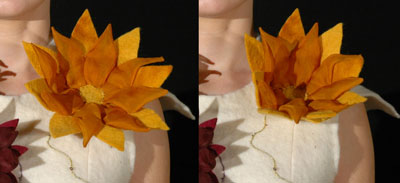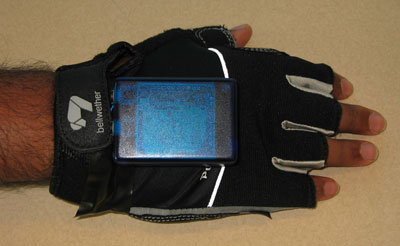The remaining four papers used RFID tags not as explicit input devices but
to automatically determine the context of wearers as they went about their
daily activities. In "Fine-Grained Activity Recognition by
Aggregating Abstract Object Usage," Donald J. Patterson and his
colleagues describe a joint University of Washington/Intel Research Seattle
study in which subjects wore a glove with an embedded RFID reader while
performing such everyday morning activities as making oatmeal, eating
breakfast, and setting and clearing the table. This research's
ultimate goal is to automatically detect "activities of everyday
living" in areas such as elder care, where staff would like a general
idea of what a resident is doing so they can tell when to move the resident
to a higher level of care. In the study, researchers placed RFID tags on
every object in the kitchen that subjects touched during a practice
trial. The tags provided the wearable with a continuous stream of
information regarding what objects the subject was touching and for how
longat a given time. The researchers then fed this data into an automatic
classifier that attempted to label the activities. The best classifier
achieved 88 percent accuracy in correctly distinguisheding among 11
interleaved and occasionally interrupted activities 88% of the time, with
60 objects tagged in the environment. This paper won this year's Best
Paper Award, the first to be awarded at an ISWC. "Hands-On RFID:
Wireless Wearables for Detecting Use of Objects" by Kenneth
P. Fishkin, Matthai Philipose, and Adam Rea, described the technical
details of the RFID-reader glove, dubbed the "iGlove."
Assaf Feldman and his colleagues from the MIT Media Lab used a similar
technique in "ReachMedia: On-the-Move Interaction with Everyday
Objects," one of this year's six best-paper nominees. This
project uses a bracelet instead of a glove and focuses more on interface
and application design issues and less on activity classification than the
previous project. The system provides just-in-time information about
objects in the environment—for example, a summary of a book the wearer is
holding. The wearer gives explicit input using simple gestures, which
wireless accelerometers in the bracelet detect. The wearable also
automatically senses what object the wearer is holding via the wireless
RFID reader. Technically, the authors call this "semi-implicit"
input: the wearable can identify the object you're holding, but you
might have to hold it a certain way to make sure the reader reads the tag,
especially with larger objects. The system speaks information about the
held objects through a cellular phone ear piece.
The final RFID paper, "RFID Information Grid for Blind Navigation and
Wayfinding" by Scooter Willis and Sumi Helal of the University of
Florida, describes a system that helps the blind navigate by embedding RFID
chips under rugs, along baseboards, and along sidewalks' edges. RFID
readers integrated into a shoe and the tip of a walking cane read the
tags. Location is read out on a cellphone.
Interface evaluations
In wearable computing's early days, most interface evaluation
studies were either highly task-driven (such as the pioneering Vu-Man
studies at Carnegie Mellon University that looked at wearables for vehicle
repair) or preliminary evaluations of what were mostly demonstrations of
new concepts or technology. As the wearables field has matured, evaluations
of wearable interfaces have become more quantitative and robust.
One such evaluation this year was "The Impacts of Limited Visual
Feedback on Mobile Text Entry for the Twiddler and Mini-QWERTY
Keyboards" by James Clawson and his colleagues, Kent Lyons, Thad
Starner, and Edward Clarkson, another best-paper nominee. This is the
latest in a series of papers from Georgia Tech on typing speeds for mobile
keyboards. Previous papers studied learning rates for the Twiddler
one-handed chording keyboard, expert Twiddler-user speeds, and Mini-QWERTY
keyboard speeds and learning rates. In this latest longitudinal study, the
authors found that experts on the mini-QWERTY keyboard can type around 60
words per minute (two-handed). This drops, however, to 46 wpm when typing
blind (for example, as you would if you were taking notes while looking at
slides or typing under the desk during a meeting). This compares to about
47 wpm (with higher accuracy) using the Twiddler one-handed chording
keyboard, which is already designed for eyes-free use. (In the interest of
full disclosure, Bradley Rhodes was on Kent Lyons' PhD thesis
committee.)
Another input-related study was "Acceptable Operating Force for
Buttons on In-Ear Type Headphones" by Vincent Buil and Gerard
Hollemans, in which the authors determined the maximum force they could
apply to a button on an in-ear headphone without causing discomfort. Buil
and Hollemans were motivated by a new interface for controlling portable
audio players (demonstrated at the conference) where you simply tap the ear
piece in a given pattern to control selection and playback.
For output, Jason Wither and Tobias Höllerer of the University of
California, Santa Barbara evaluated three techniques to enhance the
apparent depth of augmented-reality overlays in the third best-paper
nominee, "Pictorial Depth Cues for Outdoor Augmented Reality."
The first technique uses horizontal and vertical "shadow
planes" to indicate the depth of the 3D cursor and any virtual
objects by projecting their shadows on two receding grids. The second
technique displays a small top-down view of graphical objects in the
screen's bottom-left corner. The third technique uses color-coding of
markers and virtual objects to indicate their depth relative to the 3D
cursor position. Markers range from light blue to red to deep green as they
move from closer (to the user) than the cursor to further away than the
cursor. The researchers were surprised to find almost no statistically
significant differences among the techniques, but they did reduce the error
rate from around 23 percent to around 10 percent when they added other
markers to the scene to show relative depth. The authors suggest that the
head-mounted display's relatively low video resolution might have
obscured differences among the techniques, especially since subjects viewed
both graphical objects and the real world through the video screen.
Clothing design
 |
Figure 2. In a presentation by Joanna Berzowska combining
artistry
and technology, memory wire makes brooch flowers open and
close.
(figure courtesy of XS Labs, 2005)
|
We've always encouraged artistic papers at ISWC, as long as they have
technical content, but it's often hard for presenters to bridge the
culture and communications gap between the technical and artistic
communities. Joanna Berzowska's presentation on her and and
Marcelo Coelho's paper on animated kinetic dresses,
"Kukkia and Vilkas: Kinetic Electronic Garments," succeeded
admirably. The project's goal was entirely aesthetic: one dress's
hemline rises and lowers as if betraying or thwarting the wearer's
secret desires, and brooch flowers open and close of their own accord on
another dress's neckline. But the presentation included all the
technical details and lessons necessary to accomplish these creations. In
particular, the authors used Nitinol (memory wire) sewn into felt to cause
the motion. After trying many configurations, they determined that a tight
coil was the best configuration to "set" the Nitinol, as it
created the largest motion. They also determined that felt was the perfect
fabric for their projects for a number of reasons: Felt is sturdy, so when
the Nitinol relaxes back to its non-set shape, the felt pulls the dress or
flower back to the normal position. Felt is thick, so circuitry and wires
can be felted into the fabric itself. And felt is a good insulator of heat
and electricity and is relatively fire-retardant, so the wearer is
protected if the electronics short out.
Looking at clothing design from a more general perspective was
best-paper nominee "A Design Process for the Development of
Innovative Smart Clothing that Addresses End-User Needs from Technical,
Functional, Aesthetic and Cultural View Points" by Jane McCann,
Richard Hurford, and Adam Martin. Rather than presenting a specific design
or piece of research, this paper lays out a framework for thinking about
smart clothing's design. It also surveys issues ranging from
identifying the end-user's body, activity, and cultural needs to fiber
selection and layering to integrating electronics.
Recording events
In the past few years, an increasing number of projects have looked at
recording everything a wearable user does and then presenting that
information in the form of an annotated diary. The main bottleneck for such
applications isn't storage, which continues to double every year or
so, but annotating and filtering the raw data to make it browsable and
searchable. In addition to the University of Washington/Intel project
described earlier, several papers at this year's ISWC addressed this
difficult problem.
A real-world example of this annotation bottleneck is the motivation for
"Recognizing Mimicked Autistic Self-Stimulatory Behaviors Using
HMMs" by Tracy Westeyn and her colleagues. Children with the
neurodevelopmental disorder autism often engage in repetitive behaviors
such as flapping their arms or screaming. Therapists treating such children
would like to know the frequency with which these events occur to gauge
their treatment's effectiveness, but logs parents keep are notoriously
inaccurate. It's not practical for therapists to browse through days
of video footage looking for these so-called self-stimulatory
behaviors. The eventual goal of this research, which is still in its early
stages, is to provide a system with which a therapist can browse through a
relatively small number of video clips, watching the salient behaviors and
throwing out the few remaining false positives.
Also addressing this bottleneck is "Wearable Hand Activity
Recognition for Event Summarization" by Walterio Mayol and David
Murray. This project uses a shoulder-mounted active camera to capture what
you're doing with your hands, with the ultimate goal of automatically
creating video logs of how skilled artisans perform their crafts. The
system automatically detects hands by looking for skin color within the
camera's field of view and automatically pans the camera to follow
your hands as you reach for and manipulate objects. These objects are
similarly recognized by color histogram, and the video is then segmented
into individual events based on objects being held and hand motion. The
final result is a set of key-frame images, each representing a salient
moment in the overall video.
Another paper looking at the creation of video logs is the final
best-paper nominee "A Body-Mounted Camera System for Capturing
User-View Images without Head-Mounted Camera" by Hirotake Yamazoe,
Akira Utsumi, and Kenichi Hosaka. Unlike the other papers, this work
focuses on the ergonomic and fashion problems associated with head-mounted
cameras. Cameras that hang from a lanyard around the neck are far more
comfortable and socially acceptable than head-mounted cameras. However,
head-mounted cameras have the advantage of automatically capturing whatever
the wearer is looking at—likely the most important part of a scene. Built
on the authors' previous work, the system uses one wide-angled
front-facing camera and a pair of infrared cameras that look up at the
wearer's head. The system uses the image of the wearer's head to
estimate the direction the wearer is looking relative to the camera's
orientation and then extracts the region of the wide-angle image that
corresponds to that view.
These highlights are just a small sample of the 28 papers and 17 posters
presented at ISWC 2005. You can obtain the full list of papers, including
abstracts and PDFs, from the IEEE Computer Society Digital Library at www.computer.org/publications/dlib. We
also hope you'll participate in the next ISWC, to be held 11—14
October 2006 in Montreux, Switzerland. Submissions are due 21
April. Details are at the conference Web site, http://iswc.net.
 Bradley Rhodes is a
research scientist at Ricoh California Research Center and program co-chair
of the International Symposium on Wearable Computers 2005 (ISWC
05). Contact him at rhodes@bradleyrhodes.com. Bradley Rhodes is a
research scientist at Ricoh California Research Center and program co-chair
of the International Symposium on Wearable Computers 2005 (ISWC
05). Contact him at rhodes@bradleyrhodes.com.
|
 Kenji Mase is a professor
at Nagoya University and program co-chair of the International Symposium on
Wearable Computers 2005 (ISWC 05). Contact him at
mase@nagoya-u.jp. Kenji Mase is a professor
at Nagoya University and program co-chair of the International Symposium on
Wearable Computers 2005 (ISWC 05). Contact him at
mase@nagoya-u.jp.
|
Reference
- Proc. 9th IEEE Int'l Symp. Wearable Computers (ISWC 05), IEEE CS
Press, 2005.
Copyright © IEEE 2006


 Bradley Rhodes is a
research scientist at Ricoh California Research Center and program co-chair
of the International Symposium on Wearable Computers 2005 (ISWC
05). Contact him at rhodes@bradleyrhodes.com.
Bradley Rhodes is a
research scientist at Ricoh California Research Center and program co-chair
of the International Symposium on Wearable Computers 2005 (ISWC
05). Contact him at rhodes@bradleyrhodes.com. Kenji Mase is a professor
at Nagoya University and program co-chair of the International Symposium on
Wearable Computers 2005 (ISWC 05). Contact him at
mase@nagoya-u.jp.
Kenji Mase is a professor
at Nagoya University and program co-chair of the International Symposium on
Wearable Computers 2005 (ISWC 05). Contact him at
mase@nagoya-u.jp.